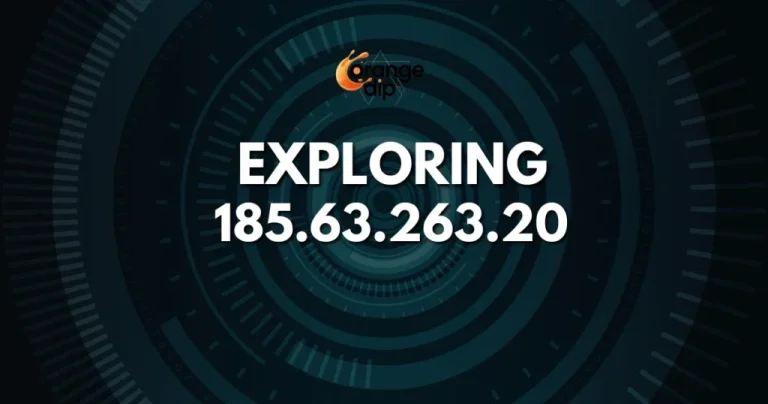
If you’ve ever checked your server logs or network alerts and seen the IP address 185.63.263.20, you might have wondered what it represents. At first glance, it looks like a standard IPv4 address, but a closer look reveals that it is invalid because the third octet exceeds the maximum allowed value of 255.
While this may seem alarming, encountering this address in your logs does not necessarily mean your system has been hacked. Instead, it often signals misconfigurations, spoofed traffic, automated scanning attempts, or logging errors. Understanding what 185.63.263.20 is, why it appears, and what risks it may pose is important for maintaining network security. In this article, we will explore the nature of this IP, explain how to investigate it, outline potential risks, and provide practical steps for protecting your systems while keeping your approach user-friendly and easy to understand.
What Is 185.63.263.20?
An IPv4 address is made of four numbers separated by periods, with each number ranging from 0 to 255. These numbers identify devices on a network. 185.63.263.20 does not follow this rule because the third octet is 263, which is invalid.
Because it is invalid:
-
There is no real device associated with this IP.
-
It cannot be routed over the internet.
-
It is often used as a placeholder, typo, or spoofed address in network logs.
In short, this is not a legitimate IP address, but it can appear in logs and monitoring tools.
Why It Appears in Your Logs
There are several reasons why this invalid IP might show up in your logs:
-
Configuration Errors: Someone may have mistyped an IP address while configuring devices, scripts, or firewall rules.
-
Spoofed Traffic: Malicious actors may intentionally use invalid IP addresses to confuse log analysis or hide their true location.
-
Automated Scanning: Bots may generate random IP addresses to probe systems for vulnerabilities.
-
Search Engine Noise: Because many users search for this address, blogs and forums referencing it can make it more noticeable in searches.
Its appearance does not automatically indicate a direct threat, but it is a signal that something unusual is happening on your network.
Potential Risks
Although the IP itself cannot directly attack your systems, it can indicate broader risks:
-
Reconnaissance: Repeated requests from unusual or invalid IPs may show that someone is probing your system.
-
Spoofing or Obfuscation: Attackers sometimes use invalid IPs to hide their real location and evade security measures.
-
Log Noise: Invalid IP addresses may clutter logs, making it harder to identify genuine threats.
Pay attention to patterns of activity around such IPs, especially repeated login attempts, unusual endpoints accessed, or spikes in requests.
How to Investigate 185.63.263.20
Here are practical steps to analyze and respond:
-
Check Server Logs: Review timestamps, request types, endpoints, and frequency of appearances.
-
Analyze Traffic Patterns: Determine if the IP is associated with failed logins, admin access, or repeated requests.
-
Set Alerts: Configure your firewall or monitoring system to flag repeated access from invalid or suspicious IPs.
-
Rate-Limit or Block: If the IP appears frequently, block or limit its access to prevent potential abuse.
-
Secure Your Systems: Ensure all services are patched, unused ports are closed, and sensitive endpoints are protected with multi-factor authentication.
-
Educate Your Team: Train your IT or security team to recognize and investigate unusual IP addresses, rather than dismissing them.
Broader Lessons for Network Security
This situation teaches several key principles:
-
Monitor Unfamiliar IPs: Regularly review logs to identify patterns of unusual activity.
-
Validate IP Addresses: Ensure your system correctly identifies valid versus invalid IP addresses.
-
Use Layered Defense: Firewalls, intrusion detection systems, and rate-limiting help protect your network.
-
Regular Log Analysis: Routine review of logs ensures early detection of potential scanning or probing attempts.
-
Maintain System Hygiene: Keep your software updated, use strong passwords, enable multi-factor authentication, and restrict unnecessary access.
By applying these principles, your network remains more resilient to both minor anomalies and larger attacks.
Baddies Hub Everything You Need to Know
Conclusion
The IP address 185.63.263.20 may initially appear alarming due to its format and repeated appearances in logs, but it is invalid because the third octet exceeds the allowable range. Its presence typically points to misconfigurations, logging errors, automated scanning, or spoofed traffic rather than a direct attack.
The key is to treat it as a signal for investigation, not panic. By reviewing logs, analyzing traffic patterns, setting alerts, and securing your systems, you can ensure your network is resilient against both minor anomalies and potential threats. Learning to identify and respond to unusual IP addresses strengthens your overall cybersecurity posture and reduces the risk of being caught off-guard. Vigilance, regular maintenance, and awareness of abnormal patterns are your best defense against the unexpected, including oddities like 185.63.263.20.
FAQs
-
Why does 185.63.263.20 show up in my logs?
It often appears due to typos, misconfigured scripts, or spoofed traffic from automated bots. -
Is this IP dangerous?
On its own, no. It cannot exist as a real device on the internet. The concern comes from patterns of traffic associated with it. -
Should I block 185.63.263.20?
Yes, especially if it appears repeatedly or exhibits suspicious behavior. Blocking can prevent potential abuse. -
How can I know if it’s part of a bigger attack?
Look for repeated requests, failed login attempts, access to sensitive endpoints, or associations with other unusual IPs. -
What general precautions should I take with unusual IPs?
Regularly review logs, secure endpoints, use firewalls, enable alerts, patch systems, and enforce strong authentication.